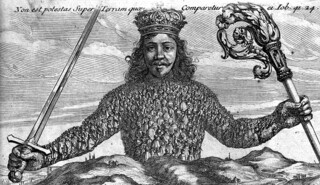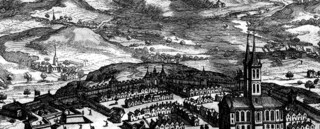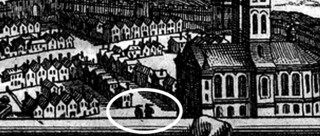Leviathan in Lockdown
Thomas Poole
The famous frontispiece to the first edition of Leviathan (1651) was designed by the engraver Abraham Bosse in close collaboration with Hobbes. The figure of Sovereignty, the massive composite body that looms over town and country, outsize sword and crozier in hand, is disquieting, at least to a modern sensibility. The subjects, all orders of men crammed together in the artificial body as if it were an early modern Wicker Man, gaze up at the crowned head. Sovereignty’s face, ringed with Stuart curls, is meant to radiate benignity, but the glass-eyed stare looks vacuous to me.
In the city below, things seem in good order. But what kind of order? The place is hardly bustling. It’s the antithesis of a painting by Bruegel. Rather than a riotous superabundance of lived life spilling out over the canvas, there is sterile order. No teeming crowds, no variety, no interaction: in fact, no apparent vitality. Nobody is out in the city’s attractive squares and avenues. (The countryside beyond the city walls is similarly depopulated.) Half a dozen figures animate one side of the city, but they are soldiers, pikemen, some patrolling the bastions, others on the parade ground.
And, right in the middle of the frontispiece, there are two figures wandering the empty city. Their clothes identify them as plague doctors, with their characteristic beaked masks, containing herbs or sponges soaked in vinegar to filter the air. I have studied the frontispiece many times, read about it and discussed it with students, but had never noticed these figures until I was alerted a few weeks ago to Francesca Falk’s book Eine gestische Geschichte der Grenze (‘A Gestural History of the Border’), which includes a substantial discussion of the plague doctors in Bosse’s engraving.
The scene is bright and sunny – conditions on land are offset by the threatening storm clouds out to sea, beyond the state’s territorial waters – and it is near the middle of the day, to judge by the shadows cast by the buildings and trees. A deserted city, barring a handful of military and medical officials, when it should be anything but. Is it far-fetched to imagine that the city is in lockdown?
Hobbes was no stranger to plague. Early modern England experienced waves of epidemics every ten years or so, some resulting in urban mortality rates as high as 20 per cent. Hobbes’s extra year as a student – it took him longer to graduate than it should have – may have been due to the cancelling of ‘Determinations’ (oral exams) because of plague, which ravaged Oxford in both 1606 and 1607.
He produced the first English translation of Thucydides’ History of the Peloponnesian War in the late 1620s. (‘There’s none that pleas’d me like Thucydides,’ he wrote in his verse autobiography.) Beginning in the second year of the war (430 BC), plague devastated Athens, taking the lives of perhaps 100,000 citizens, including Pericles. On Thucydides’ account, people reacted to the awareness of impending death with utter dejection, and the city descended into chaos. As Hobbes’s translation has it:
Neither the fear of the gods, nor laws of men, awed any man: not the former, because they concluded it was alike to worship or not worship, from seeing that alike they all perished: nor the latter, because no man expected that lives would last till he received punishment of his crimes by judgment.
Thucydides’ plague narrative suggests that if you replace fear of secular authority with blind panic about personal survival, the legal and conventional bases of social order dissolve. Without a realistic expectation that I have a future, how can I be expected to plan my actions on the basis of laws and conventions?
The propositions that emerge from Thucydides’ account of the plague also animate Leviathan. But rather than a narrative of historical events moving from order to chaos, Hobbes offers a systematic thought experiment that takes the opposite trajectory, from natural barbarism to civilisation within the state. Fear plays a structuring role throughout, both in driving mankind out of the natural condition, and in maintaining the civil condition once established. If, from one angle, Leviathan is a machine geared to produce law, from another it is a creature fearsome enough to incline us to obey. Whatever else government does, the trick it absolutely has to pull off, according to Hobbes, is to make us afraid of breaking the rules while ensuring that we have no real cause to panic about our survival. Bernard Williams described this need to secure order, protection, safety and trust as the ‘first political question’: unless it can be solved, conditions of co-operation do not exist and government cannot deliver any of the other things we might want from it.
Hobbes is often thought to have been primarily concerned with political threats to the state, such as war and rebellion. But the plague doctors’ presence in the frontispiece indicates that he was working from a broader conception of public safety. He knew from Thucydides that attacks on the city walls could take different forms, biological and psychological as well as martial. The inclusion of the plague doctors suggests that Hobbes saw protection against epidemics as one of the state’s chief duties, using both medical and regulatory measures. The first nationwide rules for dealing with plague in England date from 1579 (a few years before Hobbes was born), when the Privy Council ordered the sick, and their families, to be placed under house arrest for six weeks. Medical and civil science evolved considerably during Hobbes’s lifetime. In 1666, after the Great Plague, pest houses were introduced for the sick to be looked after in isolation from the wider community, with the cost met by nationwide taxation.
To assume that the frontispiece to Leviathan presents a normal or idealised scene is not especially comforting. The total absence of citizens combined with the presence of protective officials gives the city an air of being under a permanent state of siege. It could almost be a depiction of David Hume’s remark, a century later, that military camps ‘are the true mothers of cities’. Attentive to the disruptive power of such shocks as war, revolution and plague, Hobbes undervalues the more insidious but still threatening proposition of a locked-down population forced to adopt a siege mentality. Fear and disillusionment do their work here, too. We may underestimate, perhaps half on purpose, the camp-like quality of our cities even in ‘normal’ times, and accept that it is sometimes necessary for cities temporarily to become camps. But bare life is not enough. We don’t just want to be preserved, we want also to live.




Comments
-
2 May 2020
at
7:54pm
Paul Sagar
says:
Thanks so much for this! Last semester, I was teaching my 'Advanced Texts in Political Theory' module with a colleague, where we take third year UG students through just one text, over a 10 week course, with an emphasis on careful, slow, close reading. This year we selected Leviathan as the work to study. Like so many, we had to run the last two seminars of the semester remotely over MS Teams.
-
5 May 2020
at
6:32pm
Jacob Hougie
says:
Is it not alternately possible that the lack of people is explained by their presence in the body of Leviathan?
-
6 May 2020
at
7:23am
Luke Alex Atkinson
says:
@
Jacob Hougie
This is where my mind went as well, Jacob. Perhaps the people are depicted as the Leviathan, but are supposed to be read as still being in the city.
-
5 May 2020
at
8:00pm
Duncan Hunt
says:
Very interesting piece, however I find it hard to read the figures as having beaked masks. The line of the 'beaks' are continuous with a line emerging from the base of the house to their left, and I see the lines as rekated to the ground heyond the figures. Also I read the figures' bodies as inclined to their left, so if the cowls are beaked the heads would have to be turned at an odd angle in the opposite direction. Just my perspective of course. They are dark and ominous figures, but bearing in mind their positioning perhaps they represent Hobbes and his reader looking onto the landscape of his book.
-
6 May 2020
at
9:36am
Duncan Hunt
says:
@
Duncan Hunt
Looking at the drawing of the frontispiece Daniel references below I can see the figures are clearly wearing beaked masks. Fascinating detail.
-
6 May 2020
at
12:55am
Daniel Brownstein
says:
It is striking that the two plague doctors seeming to patrol the empty city streets were included in the drawing of the frontispiece that Hobbes presented to Charles II--they turn out, perhaps, even better.
-
6 May 2020
at
10:00am
Richard Fox
says:
@
Daniel Brownstein
Whatever they are, it is surely more likely that they are the invention of the artist, rather than some careful metaphor thought up by Hobbes.
-
10 May 2020
at
12:35am
Adam Chmielewski
says:
It is a strong temptation is to conceptualize the present condition of ubiquitous fear by resorting to the Hobbesian concept of the state of nature, in which human life is “solitary, poor, nasty, brutish and short” and in which the people find rescue in the submission to the power of the state, this mighty Leviathan who, assuming absolute power, agrees to protect the people from each other. The temptation should be resisted.
-
13 May 2020
at
2:28pm
Daniel Nemenyi
says:
Having studied Bosse's frontispiece in a 17C copy of Leviathan at the British Library, I had noticed those two figures before - they tend to be somewhat smudged in the editions of today (which says something about about the state of printing three centuries on). However I have never found reference, let alone an explanation of them, so this is welcomed. However I'm not entirely convinced. If you look at the figures closely enough - and with a clearer image than that above - they appear, from their stance, to be looking towards the guards, with the points thereby being at their backs like connical hats, rather than a plague doctor mask. Perhaps they are noble women wearing hennins? Two unnoticed women in a scene of men, bearing witness to the guards, or perhaps turned to the Leviathan himself from the furthest point on the page possible.
Read moreDespite also teaching this book to students for over 10 years now, I too had never noticed those plague doctors. Having spent an hour on the frontispiece in our first class, it seems incredible given what we now know that we all missed this. But then, we can all be sure that none of us will ever miss it again.
I'm forwarding this along to the cohort now, as they'll be able to relate more than ever.
Under that interpretation the two remaining figures may represent those that have failed to recognise the Leviathan's representation.
It seems that everyone actually depicted in the city is associated with law and order (soldiers, doctors), so maybe they are already part of the Leviathan and don't need to be depicted as part of the body?
https://www.pbase.com/hobbes/image/151739929
It is true that the scared people are now more afraid of each other than of their Leviathans. It is also true that, at the present moment, docility is an optimal strategy for survival, and accordingly the people look to their respective Leviathans to protect them from harm. Yet one has to remember several things. Firstly, it has been made manifest by the virus how serious and responsible the business of politics is, and how irresponsible we were to have been treating it so nonchalantly. For it is owing to ourselves that the present-day Leviathans are personified by weak, incompetent, mendacious and corrupt politicians, ineptly managing the ill-designed institutions. Secondly, politicians fear no less than the people do. Thirdly, what the politicians are afraid of is not that their weaknesses, incompetence, lies and corruption will be exposed, for these are obvious enough to anyone paying attention. What the politicians fear most is that as soon as the pandemic abates, the people’s fear will transform itself into a widespread discontent and anger, and that the anger will be directed against them. Finally, irrespective of whether the authorities succeed or fail in dealing with the pandemic, the loss of life and material damage affecting countless people will be vast. One possible outcome is that the resulting anger might turn public agoraphobia into public agoraphilia, interpassive relationships into interactive ones, social distancing into social proximity, and the abstractness of our societies into tangible concreteness, thus creating a revolutionary situation. Politicians will be forced to face it. What is also already obvious, however, is that they, just as the existing agencies of neoliberal states, are completely unprepared for this. In view of the unsustainability of the present political, economic and ecological disorder, what should be feared is not the much-needed revolution but the continuation of our political docility. Our current condition of global incapacitation does not bode well for the future: so far, the virus does the revolution for us, and instead of us.
Another curious detail - they are also far bigger than the strutting guards, almost as big as the terraces behind them, as though they're closer in perspective, standing outside the houses or penned in as an addition.